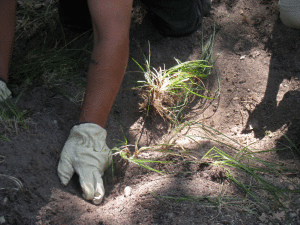ETHNOBOTANY: A RELATIONSHIP WITH PLANTS
By Sara French Sara French is a research associate for the AMLT and the ethnobotanist for the Amah Mutsun Tribal Band. Ethnobotany is the study of the human relationship with plants. We all engage in ethnobotanical relationships every day, but for many of us our relationship with plants is disconnected. We buy plant based foods and medicines from a store rather than gathering or growing them ourselves, but in the not so distant past our ancestors got the foods, medicines, and raw materials they needed directly from the land. This personal relationship with plants required detailed knowledge about how to find, gather, prepare, and care for the hundreds of plants that provided the backbone of life. The Amah Mutsun are working to restore their traditional relationship with native plants in order to fulfill their stewardship obligation to the Creator, maintain wellness within their tribe, and continue on the path of their ancestors. The importance of native plants to the Amah Mutsun cannot be overstated. Prior to European contact, plants provided food, medicine, construction and craft materials, clothing, tools, instruments, detergents, and cosmetics for the Mutsun people. In the 1930s the anthropologist John P. Harrington interviewed Mutsun elders and recorded 157 plants that were traditionally used. These included 63 different plants collected for food, 101 collected for medicine, and 48 used as raw materials1. Because Harrington interviewed only a handful of Mutsun people, his notes likely provide an incomplete account of the true diversity of plants in the Amah Mutsun ethnobotany. Each of these plants is associated with a rich history of traditional ecological knowledge about where to find the plants, how and when to harvest them, how to manage them, and how to turn them into foods, medicines, and other useful materials. The Amah Mutsun accumulated this knowledge over thousands of years because they lived connected to the land and engaged in direct relationships with plants every day. We cannot talk about Amah Mutsun ethnobotany without also talking about the traditional resource and environmental management (TREM) practices associated with Mutsun plant use. Rather than domesticating plants and developing agriculture in the conventional sense, the Amah Mutsun maximized the natural bounty of California by tending the landscape in a way that maintained a highly productive and diverse patchwork of habitats and native plant resources. TREM in indigenous California included weeding, tilling, pruning, thinning fruits, selective harvesting, soil management, seed broadcasting, and controlled burning. This active management, combined with sustainable harvest techniques, ensured that native plant populations maintained their productivity and health over time. Equally important was the spiritual relationship with the plants, which was expressed through prayer, ceremonies, and songs that were given to the Amah Mutsun by the Creator to help them fulfill their stewardship responsibilities.
AMLT Native Stewardship Corps recording ethnobotanical information on Midpeninsula Regional Open Space District lands. Photo courtesy Sara French.







